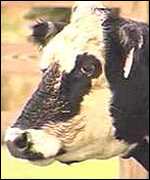
BBC News
URL: http://news.bbc.co.uk/hi/english/sci/tech/newsid_1113000/1113719.stm
Date accessed: 15 January 2001
Friday, 12 January, 2001, 11:58 GMT

At one day old, Noah began to exhibit symptoms of a common infection,
and succumbed to it despite our treatment efforts
|
|
Dr Jonathan Hill, Cornell University
|
The clone was carried to term by a cow called Bessie.
"The data collected clearly indicate that cross-species cloning worked and, as a scientist, I am pleased," explained Dr Philip Damiani, a researcher with ACT.
"As a person, however, I am saddened that an animal died. In the short period of time Noah was with us, he showed himself to be a vigorous and friendly calf."
Habitat loss
The animal researchers cloned is a wild ox native to Asia. The gaur is generally brown or black with a humplike ridge on its back and with white or yellow stockings on all four legs.

Gaur numbers have dwindled to about 36,000
|
Some researchers believe cloning may offer the only way to save such species from extinction. And the particular circumstances of Noah's cloning also suggest that animals that have recently gone extinct could be brought back into existence.
But conservationists argue there is little point pursuing difficult and expensive technology if the reasons for an animal's decline or disappearance, such as habitat loss, have not been addressed first.
Skin cells
Researchers, working under the direction of Dr Jonathan Hill, from Cornell University, said they did everything possible to save the baby bull.

He weighed 36 kilos (80 lbs) at birth
|
Noah was produced in a cross-species cloning procedure.
The genetic material taken from the skin cells of a male gaur, which had died eight years previously, were fused with the emptied egg cells of common cows.
Learning process
From a total of 692 eggs used in the experiment, only one live clone was produced - Noah.

Bessie, the "mother", remains fit and well
|
"Science has advanced to the point of being able to successfully create a healthy trans-species gaur clone," said Dr Kurt Benirschke, former president of the Zoological Society of San Diego and founder of the "Frozen Zoo".
"The Zoological Society is saddened by the news of Noah's death. Still, we are encouraged that scientists are learning to perfect this process and have continued hope for its inevitable role in the conservation of endangered species."
Category: 33. Cloning